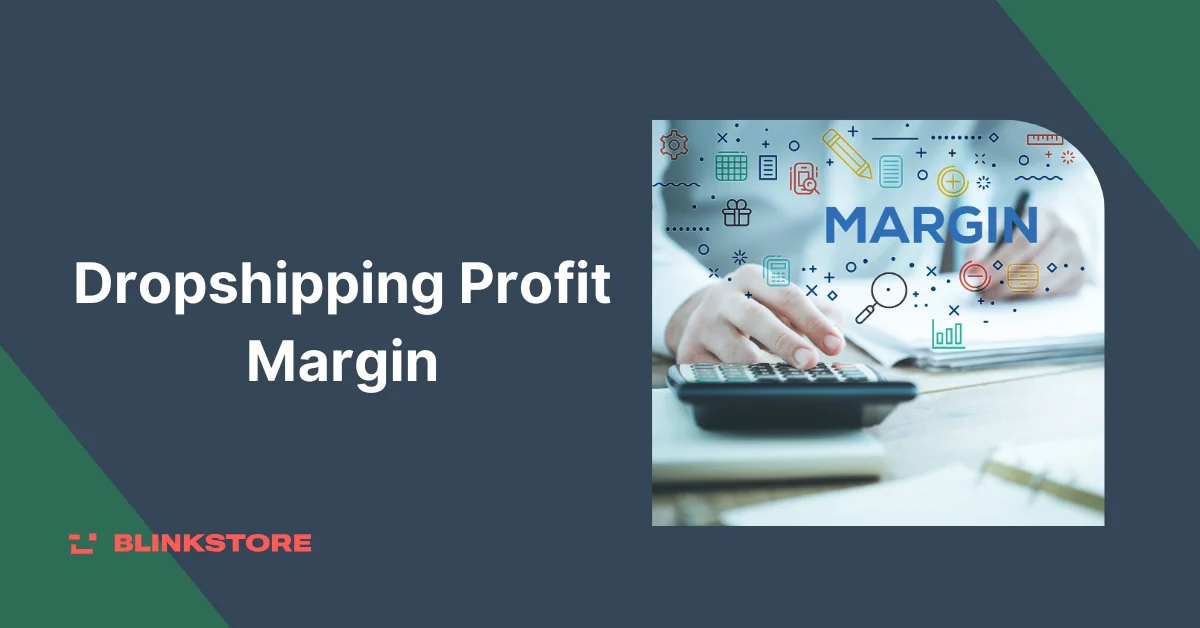Dropshipping has become a favored business model for entrepreneurs due to its low startup costs and flexibility. However, understanding profit margins is essential for success in this field. This article explores the concept of dropshipping profit margins, providing practical tips on how to calculate and improve them. Whether you’re new to dropshipping or looking to refine your pricing strategy, mastering profit margins is key to maximizing your earnings and sustaining long-term growth.
Table of Contents
What is Profit Margin on Dropshipping?

The dropshipping profit margin is the percentage of profit a seller makes from selling a product through dropshipping after covering the product’s cost and other expenses. In dropshipping, the seller doesn’t keep inventory but forwards customer orders to the best dropshipping suppliers who ships the product. The profit margin is the difference between the selling price and the supplier’s cost.
To improve margins, sellers can focus on cutting costs, negotiating better deals with suppliers, and targeting niche markets where they can charge higher prices. The key is to price products in a way that covers all costs while still making a good profit.
Formula:
The formula to calculate the dropshipping profit margin is:
{(Sales Price – Costs) / Sales Price} x 100 = Profit Margin
Where:
- Selling Price is the price at which the product is sold to the customer.
- Cost of Goods Sold (COGS) includes the cost paid to the supplier, shipping fees, and any other direct costs associated with selling the product.
This formula helps you determine how much profit you’re making on each sale. A healthy profit margin is key to sustaining a dropshipping business in the long term.
Factors Influencing Dropshipping Profit Margin

Several factors can impact your dropshipping profit margin:
- Product Cost: The price at which you purchase the product from the supplier.
- Shipping Fees: Shipping costs can eat into your profits, especially if you’re offering free shipping to customers.
- Payment Gateway Fees: Platforms like PayPal or Stripe charge transaction fees, which reduce your net profit.
- Advertising Expenses: Marketing costs, especially for paid ads, can significantly affect your margins.
Average Dropshipping Profit Margin
The average dropshipping profit margin typically ranges from 15% to 30%. This percentage represents the portion of revenue a dropshipping business retains as profit after covering all costs, including the cost of goods sold (COGS), shipping, marketing, and platform fees. The exact margin can vary based on several factors, including the type of products sold, the competition in the market, and the efficiency of the business’s operations.
A higher dropshipping profit margin is often achievable in niche markets where there is less competition, allowing sellers to charge premium prices. On the other hand, in highly competitive markets, margins may be lower because sellers might have to reduce prices to attract customers. For many businesses, understanding and maintaining an optimal margin is key to long-term success.
To determine their average dropshipping profit margin, businesses often use a dropshipping profit margin calculator. This tool helps sellers input various costs, such as product cost, shipping, and other related expenses, and calculate their profit margin as a percentage of the selling price. By regularly using a dropshipping profit margin calculator, businesses can better understand their profitability and make informed decisions on pricing, cost management, and marketing strategies.
The average dropshipping profit margin serves as a benchmark, helping sellers assess whether they are pricing their products effectively. For instance, if a seller finds their margin below the average range, they might explore ways to reduce costs or increase their selling price without losing competitiveness. Conversely, if the margin is above average, it might indicate that the business is operating efficiently, offering potential to reinvest in growth or explore new opportunities.
Calculating Profit Margins: The Dropshipping Profit Margin Calculator

A dropshipping profit margin calculator is an essential tool for any dropshipper. It helps you accurately calculate your profit margins by inputting variables such as product cost, selling price, shipping fees, and other expenses.
How to Use It:
- Input Product Cost: Enter the cost price from your supplier.
- Set Selling Price: Determine the price at which you plan to sell the product.
- Add Shipping Costs: Include the cost of shipping to the customer.
- Include Transaction Fees: Add any payment gateway or platform fees.
- Calculate: The calculator will provide your profit margin percentage.
Using a dropshipping profit margin calculator regularly ensures that you’re pricing products correctly and maximizing profits.
What is a Good Profit Margin for Dropshipping?
Determining what constitutes a good profit margin in dropshipping depends on several factors, including your business model, niche, and target market.
Ideal Profit Margins:
- New Businesses: Aim for a 20-30% margin to cover initial costs and marketing expenses.
- Established Businesses: A 30-50% margin allows for better sustainability and growth.
A good profit margin for dropshipping should also factor in long-term scalability. While higher margins are desirable, they should not compromise customer satisfaction or market competitiveness.
Key Profit Margin Metrics for a Dropshipping Business
Understanding key profit margin metrics is essential for running a successful dropshipping business. These metrics help determine profitability and guide decision-making. Here’s a detailed explanation of the most important profit margin metrics:
1. Cost of Goods Sold (COGS)
The Cost of Goods Sold (COGS) is one of the most crucial metrics in determining your profit margin. COGS represents the direct costs associated with producing and delivering the products sold. For a dropshipping business, this includes the wholesale price paid to the supplier and any additional costs like packaging and handling fees.
Accurately calculating COGS is essential because it directly affects the gross profit margin. A lower COGS means a higher gross profit, assuming sales prices remain constant. However, it’s important to factor in any hidden costs, such as supplier fees or currency conversion charges, that can increase the overall COGS and reduce profit margins.
2. Average Order Value (AOV)
Average Order Value (AOV) is the average amount a customer spends per order on your site. It’s calculated by dividing the total revenue by the number of orders within a specific time frame. A higher AOV indicates that customers are spending more per transaction, which can significantly impact your profit margins.
For a dropshipping business, where margins can be thin, improving AOV is a critical strategy to maximize profitability without increasing customer acquisition costs. For example, offering complementary products or limited-time discounts on bulk purchases can encourage customers to spend more per transaction.
3. Conversion Rate
Conversion rate is calculated by dividing the number of conversions (sales) by the total number of visitors and multiplying by 100. A higher conversion rate means more of your traffic is being converted into paying customers, which can lead to higher profits.
Improving your conversion rate is vital because it directly impacts your revenue without the need to increase traffic. Strategies to boost conversion rates include optimizing product pages, simplifying the checkout process, offering various payment options, and providing clear product descriptions and high-quality images. In dropshipping, where customer trust is paramount, ensuring a smooth and transparent shopping experience can significantly enhance conversion rates.
4. Shipping Costs
Shipping costs play a significant role in determining profit margins in dropshipping. Unlike traditional retail models, where you might have more control over shipping logistics, dropshipping relies heavily on the supplier’s shipping rates and methods. These costs can vary widely depending on the product’s weight, dimensions, destination, and shipping speed.
Minimizing shipping costs while maintaining delivery speed and reliability is a delicate balance. Offering free shipping, for instance, can attract more customers but might eat into your profit margins if not managed carefully. To optimize shipping costs, consider negotiating better rates with your suppliers, using flat-rate shipping options, or including shipping costs in the product price.
5. Returns and Refunds
Returns and refunds are inevitable in any e-commerce business, and they can significantly impact your profit margins. The cost of processing returns includes the potential loss of sales, restocking fees, and the cost of returning the product to the supplier, which can sometimes exceed the product’s value.
To minimize the impact of returns, it’s essential to have clear and customer-friendly return policies, ensure accurate product descriptions, and maintain high product quality. Additionally, analyzing the reasons for returns can help you identify and address underlying issues, such as product quality or customer dissatisfaction, which can reduce future returns and improve overall profitability.
6. Gross Profit Margin
Gross profit margin is calculated by subtracting COGS from total revenue and then dividing by total revenue. This metric provides insight into how efficiently a business is producing and selling products.
A high gross profit margin indicates that the business is generating more profit per dollar of revenue, which can be reinvested into marketing, product development, or other growth initiatives.
7. Net Profit Margin
Net profit margin is the percentage of revenue left after all expenses, including COGS, shipping, returns, marketing, and overhead, have been deducted. It’s a comprehensive measure of profitability and indicates how much profit the business makes for every dollar of revenue.
A strong net profit margin signifies that the business is not only generating revenue but also effectively managing its costs.
8. Customer Acquisition Cost (CAC)
Customer Acquisition Cost (CAC) refers to the cost of acquiring a new customer, including marketing and advertising expenses. It’s calculated by dividing the total cost of marketing efforts by the number of new customers acquired.
For a dropshipping business, optimizing CAC is crucial because a high CAC can quickly erode profit margins, especially if AOV or LTV (Lifetime Value) isn’t high enough to offset these costs. Strategies to reduce CAC include focusing on organic traffic through SEO, leveraging social media, and running targeted ad campaigns with a clear return on investment.
Strategies to Increase Dropshipping Profit Margins

To increase profit margins, focus on these five key strategies:
1. Adjust Your Pricing: Regularly review your prices to ensure they reflect the market demand and competition. You can charge more for high-value or niche products, which can boost your profit margins.
2. Negotiate with Suppliers: Work closely with your suppliers to get better deals, such as discounts for buying in bulk or lower prices overall. This reduces your costs, which increases your profits.
3. Cut Operating Costs: Look for ways to reduce expenses in your business, like automating tasks or finding cheaper shipping options. Lowering costs without sacrificing quality will directly improve your profit margins.
4. Promote High-Margin Products: Focus on selling products that give you the most profit. By pushing these items more, you can increase your overall earnings.
5. Encourage Repeat Business: Keep your customers coming back with great service, loyalty programs, and personalized offers. Loyal customers are less likely to switch to competitors, helping you save on marketing costs and improve margins.
Common Mistakes That Can Erode Profit Margins
Understanding the potential pitfalls that can erode your dropshipping profit margin is essential. Common mistakes include:
- Underpricing Products: Competitive pricing is crucial, but underpricing can lead to unsustainable margins.
- Ignoring Hidden Costs: Overheads like returns, chargebacks, and currency conversion fees can reduce profitability.
- Over-Reliance on Paid Ads: While advertising is necessary, over-spending without measuring ROI can deplete profits.
Avoiding these mistakes helps maintain a healthy dropshipping profit margin.
How to set prices for your dropshipping products?
Pricing dropshipping products might seem tricky, but it becomes straightforward when you know the right formulas and set clear eCommerce goals. Even the best dropshipping ideas will only succeed if they have a solid pricing strategy. Price too high, and you’ll drive customers away; price too low, and you’ll lose money and burn out.
Here are some tips on how to set prices for your dropshipping products:
First, understand that the ideal markup will vary for each product you sell. You can’t just apply the same percentage to all items. Lower-cost products often have higher profit margins than more expensive ones. For example, you might earn more from selling socks than electronics. However, you’ll need to sell a lot more socks to make the same amount of money. Pricing should be specific to each product to maximize your profits.
Second, think long-term when setting prices. It might be tempting to raise prices as high as possible to make quick money. While this might work for a while, it can harm your brand and even destroy your business in the long run. Many short-lived dropshipping businesses have used this approach, leading consumers to question whether dropshipping is still viable or even legal.
Third, don’t forget to factor in advertising costs. While these costs might not be part of the basic profit margin formula, they are crucial for dropshipping businesses. Ads are often the main source of traffic and sales for dropshipping stores. If your prices don’t cover advertising costs, you’ll lose money every time you run an ad.Shipping
Start your dropshipping business with Blinkstore

Starting your dropshipping business with Blinkstore is a straightforward process that allows you to create an online store without the hassle of managing inventory or handling shipping. Here’s how you can get started:
First, sign up for a Blinkstore account. The platform is user-friendly and guides you through the initial setup process, making it easy even for beginners. Once you’re registered, you can begin building your online store by choosing a name and customizing your store’s design to reflect your brand’s identity.
Next, browse through the wide range of products available on Blinkstore. The platform offers a variety of categories, so you can select products that align with your niche or target market. Add the chosen products to your store, ensuring that you include detailed descriptions, high-quality images, and competitive pricing. Blinkstore makes it easy to import products directly into your store, so you can focus on other aspects of your business.
After your products are listed, set up your payment methods. Blinkstore integrates with popular payment gateways, allowing you to accept payments from customers around the world securely. It’s essential to ensure that your payment setup is smooth to provide a seamless checkout experience for your customers.
Once everything is in place, promote your store. Blinkstore provides tools to help you manage your marketing campaigns and track your store’s performance, so you can make data-driven decisions to grow your business.
Finally, as orders start coming in, Blinkstore handles the fulfillment process. They take care of inventory, packaging, and shipping, allowing you to focus on scaling your business and providing excellent customer service. With Blinkstore, you can efficiently run a dropshipping business without worrying about the complexities of logistics.
Summary
Successfully managing your dropshipping profit margins is vital to building a profitable and sustainable business. By carefully calculating costs, setting competitive prices, and consistently evaluating your margins, you can ensure that your dropshipping venture remains lucrative. Utilizing tools like a profit margin calculator and focusing on strategies that boost profitability will help you stay ahead in the competitive eCommerce landscape. With the right approach, your dropshipping business can thrive and generate significant returns.
FAQs on Dropshipping Profit Margin
What is a dropshipping profit margin?
It’s the percentage of profit you earn from selling a product after deducting costs like product price, shipping, and fees.
How can I improve my dropshipping profit margins?
Focus on reducing costs, negotiating better deals with suppliers, and pricing your products strategically to cover all expenses.
What is the average dropshipping profit margin?
The average profit margin typically ranges from 15% to 30%, depending on product type, market competition, and business efficiency.
What common mistakes can reduce dropshipping profit margins?
Underpricing products, ignoring hidden costs, and over-reliance on paid ads can significantly erode profit margins.
How should I set prices for dropshipping products?
Underpricing products, ignoring hidden costs, and over-reliance on paid ads can significantly erode profit margins.
